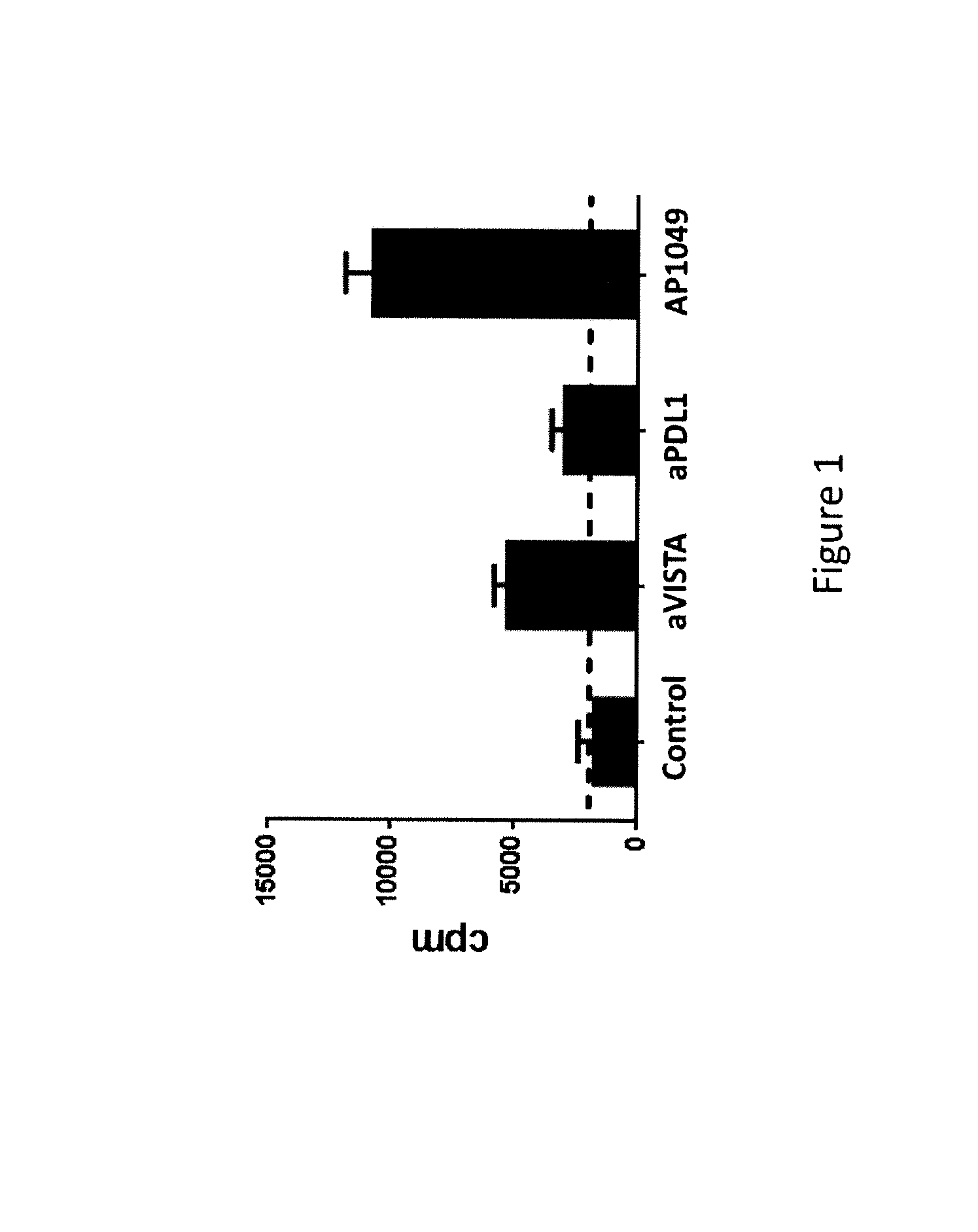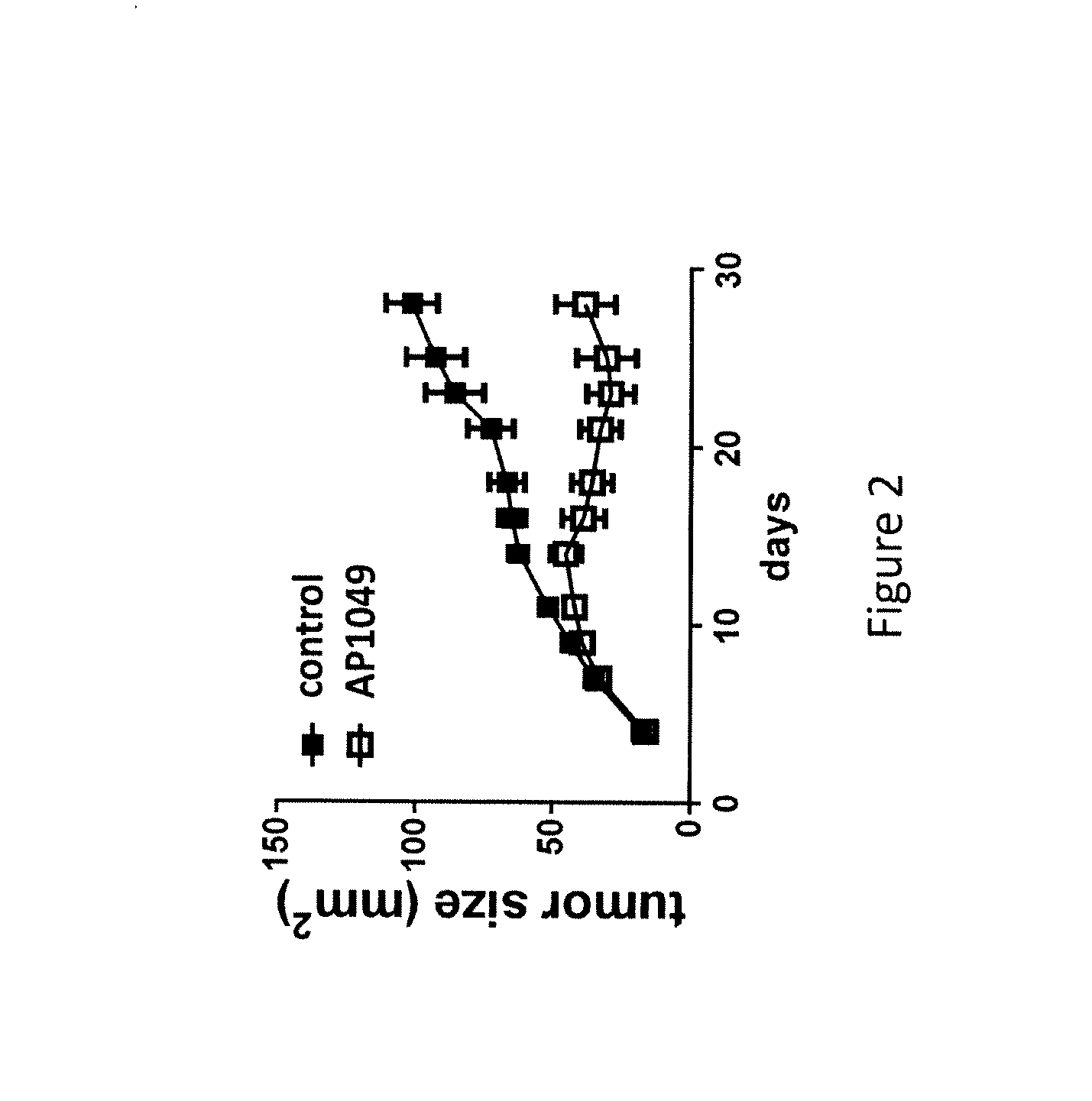Vista antagonist and methods of use
a technology of vista and antagonist, which is applied in the direction of instruments, peptides/protein ingredients, peptides, etc., can solve the problems that ctla-4 ko mice cannot adequately control inflammation and develop systemic autoimmune diseases, and achieve the effect of reducing or inhibiting vista-mediated t cell suppression
- Summary
- Abstract
- Description
- Claims
- Application Information
AI Technical Summary
Benefits of technology
Problems solved by technology
Method used
Image
Examples
example 1
Materials and Methods
[0177]Peptide Synthesis.
[0178]AP1049 (SSACDWIKRSCH-amide, wherein Cys4-Cys11 form a disulfide bridge; SEQ ID NO:1 (Ser-Ser-Ala-Cys-Asp-Trp-Ile-Lys-Arg-Ser-Cys-His)) and scrambled negative control sequence (SSACKSWRDICH-amide, wherein Cys4-Cys11 form a disulfide bridge; SEQ ID NO:2) were prepared using standard Fmoc-based solid-phase peptide synthesis (SPPS). The peptides were purified via HPLC, and analyzed by mass spectrometric using the liquid chromatography-mass spectrometry (LC-MS) and matrix-assisted laser desorption / ionization (MALDI)
[0179]Peptide Discovery Using Phage Display.
[0180]An M13 phage peptide library was provided by Dr. Brian Kay (U. Illinois-Chicago). The VISTA protein required for both the phage display biopanning experiments and the confirmatory ELISA binding experiments was prepared by conventional recombinant protein techniques.
[0181]T Cell Proliferation Assay.
[0182]An VISTA-Ig fusion protein or control Ig fusion protein was co-absorbed to ...
example 2
Enhancement of T Cell Proliferation
[0191]VISTA+CD11b+ monocytes were enriched from naïve splenocytes using CD11b magnetic beads (Miltenyi). VISTA+CD11bhi MHCII+ myeloid APCs were FACS sorted, irradiated (2500 rads), and used as antigen-presenting cells to stimulate OT-II transgenic CD4+ + T cells in the presence of OVA peptide. Control-Ig, monoclonal antibody specific for VISTA and PD-L1 (30 μg / mL), or VISTA-specific peptide (100 μg / mL) were added as indicated. Cell proliferation was measured by tritium incorporation during the last 8 hours of a 72-hour assay. This analysis indicated that T cell proliferation was enhanced in the presence of VISTA or PD-L1 neutralizing monoclonal antibodies, or the AP1049 peptide (FIG. 1). In fact, the AP1049 peptide stimulated T cell proliferation much better than either of the monoclonal antibodies, indicating that the peptide possesses strong antagonistic activity against VISTA.
example 3
Enhancement of Anti-Tumor Immunity
[0192]Immunogenic bladder carcinoma tumors (MB49) were inoculated in female mice. AP1049 was tested for its ability to slow tumor growth and / or facilitate tumor regression. The readout for this assay was tumor growth.
[0193]MB49 tumors were inoculated in female mice (300 k) via intradermal (i.d.) inoculation, which facilitates measurement of tumor size. Mice were treated with either PBS (control) or VISTA antagonist peptide (AP1049), via daily injections around tumor mass starting on day +1 and continuing for 2 weeks. Tumor size was measured by caliper every 2-3 days.
[0194]Using these methods slowed tumor growth and / or tumor regression in mice treated with AP1049 was obtained as compared with mice treated with control.
[0195]As shown in FIG. 2, AP1049 treatment reduced tumor growth in the MB49 tumor model, indicating that the peptide may bind to the critical / active site of VISTA and block the immune-suppressive function of VISTA.
PUM
| Property | Measurement | Unit |
|---|---|---|
| pH | aaaaa | aaaaa |
| binding affinity | aaaaa | aaaaa |
| stability | aaaaa | aaaaa |
Abstract
Description
Claims
Application Information
 Login to View More
Login to View More - R&D
- Intellectual Property
- Life Sciences
- Materials
- Tech Scout
- Unparalleled Data Quality
- Higher Quality Content
- 60% Fewer Hallucinations
Browse by: Latest US Patents, China's latest patents, Technical Efficacy Thesaurus, Application Domain, Technology Topic, Popular Technical Reports.
© 2025 PatSnap. All rights reserved.Legal|Privacy policy|Modern Slavery Act Transparency Statement|Sitemap|About US| Contact US: help@patsnap.com


